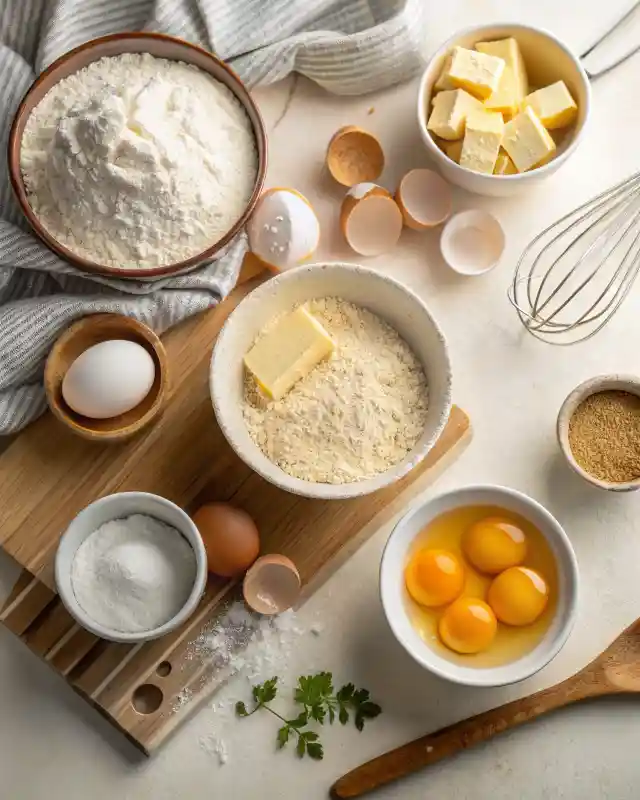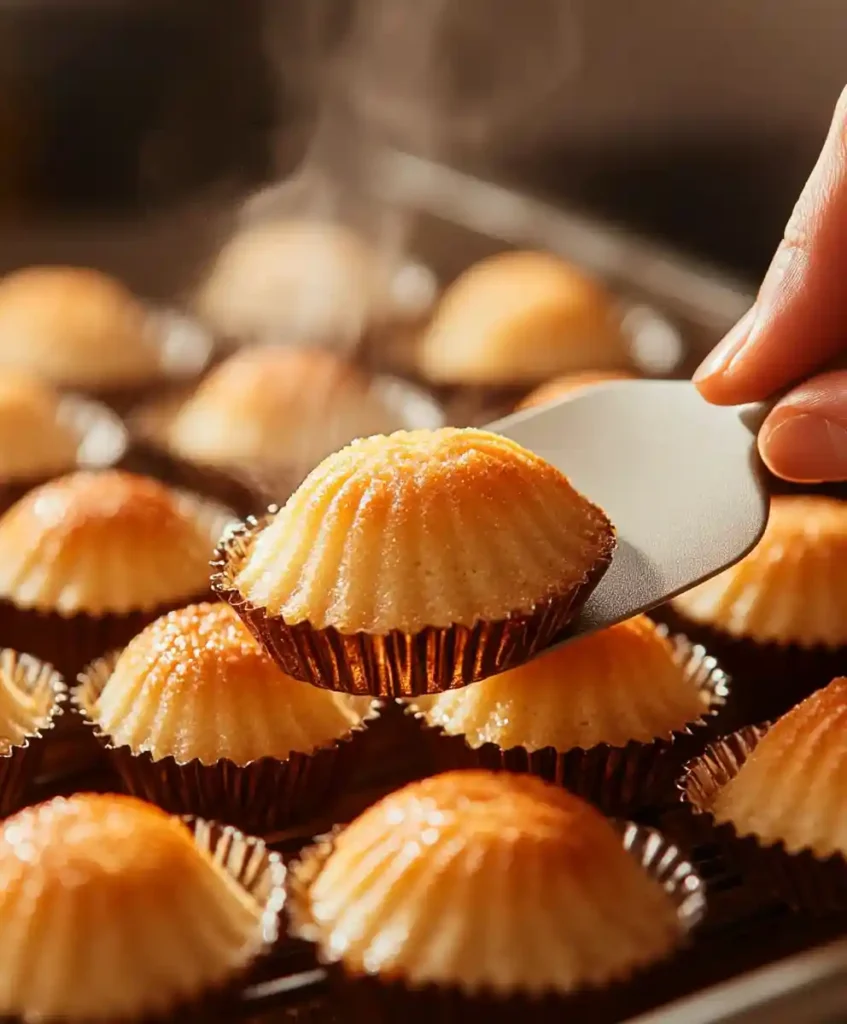Introduction
Madeleines are delightful little French sponge cakes known for their distinctive scalloped shape and delicate crumb. They’re often enjoyed with tea or coffee as a light, buttery treat. But if you’ve ever baked a batch, you’ve likely wondered how to keep madeleines moist once they come out of the oven.
Achieving the perfect soft texture requires attention to key factors like ingredient selection, mixing techniques, and proper storage. Without the right approach, these delicate cakes can dry out quickly. In this ultimate guide, we’ll walk you through the essential steps, pro tips, and best practices that address how to keep madeleines moist for longer. From choosing the right ingredients to perfecting your baking technique, every detail matters in preserving the melt-in-your-mouth texture that makes these treats so special.
If you’ve struggled with dryness before, learning how to keep madeleines moist can make all the difference. Simple adjustments, such as proper cooling methods and airtight storage, can help retain moisture for an extended period. Whether you’re a novice or a seasoned baker, mastering how to keep madeleines moist will ensure that every batch stays soft, fresh, and utterly delicious, delivering the perfect bite every time.
1. Understanding Why Madeleines Dry Out
Madeleines can easily become dry due to several factors, such as overbaking, insufficient butter content, or incorrect storage. One of the key aspects of how to keep madeleines moist is ensuring they retain enough moisture from the moment they leave the oven. These dainty cakes have a higher surface area relative to their volume, which means they lose moisture quickly. If you don’t pay attention to details like oven temperature or sealing them in an airtight container, you’ll struggle with how to keep madeleines moist for an extended period. Proper cooling, gentle handling, and strategic storage all play a crucial role in how to keep madeleines moist and delicious for longer.
To truly master how to keep madeleines moist, it’s important to understand that even slight changes in baking time and temperature can make a noticeable difference. Because madeleines bake quickly, a few extra minutes in the oven can turn them from moist and tender to dry and crumbly. Fortunately, paying close attention to the process can help you avoid these pitfalls and achieve perfectly moist results every time.
2. Choosing the Right Ingredients for Moisture
One of the secrets behind how to keep madeleines moist is in selecting high-quality, fresh ingredients. While the classic madeleine recipe typically includes flour, butter, sugar, and eggs, small tweaks can ensure optimal moisture retention.

Flour Selection
- All-Purpose Flour: This is the traditional choice for most madeleine recipes. It provides a delicate crumb while still giving the batter enough structure.
- Cake Flour: Some bakers prefer cake flour for an even lighter texture. However, if the flour is too fine, you risk losing a bit of that classic scalloped rise.
Butter Quality
- Unsalted Butter: Using unsalted butter lets you control the salt content precisely. Look for high-fat varieties to maintain a plush crumb.
- Temperature Control: Melted butter must not be too hot when mixed into the batter. This prevents the eggs from curdling and helps keep the overall texture moist.
Sugar & Sweeteners
- Granulated Sugar: Standard white sugar is common in madeleine recipes. It helps develop a slightly crisp exterior while keeping the inside soft.
- Powdered Sugar: Sometimes used in place of granulated sugar for a finer crumb, but it can also alter the structure of the cake.
Eggs & Flavorings
- Eggs: Fresh eggs not only add flavor but also help trap air in the batter. This air contributes to the signature “hump” of a perfectly baked madeleine.
- Vanilla Extract or Citrus Zest: These flavorings can enhance the taste, but they also slightly affect moisture content. Balance is key.
By thoughtfully choosing and balancing these ingredients, you’re already taking the first steps in learning how to keep madeleines moist for as long as possible.
3. Proper Batter Preparation
The preparation process is just as vital as the ingredients themselves. If you whip too much air into the batter, your madeleines may rise too quickly and dry out. Conversely, too little mixing can result in dense, under-aerated cakes.
- Creaming Technique: If your recipe calls for creaming butter and sugar, do it until light and fluffy. This helps maintain a moist interior by incorporating tiny air bubbles that expand during baking.
- Gentle Folding: Once you introduce dry ingredients, fold them gently to prevent over-mixing. A light hand helps preserve the air you created in earlier steps.
- Resting Time: Many classic madeleine recipes recommend resting the batter in the fridge for at least 30 minutes to an hour. This rest allows the flour to hydrate fully, which can improve the crumb and help keep the madeleines moist.
- Consistent Thickness: Ensure that each madeleine mold is filled with the same amount of batter. Inconsistent portions can lead to uneven baking and dryness in some pieces.
This attention to detail during batter preparation plays a pivotal role in how to keep madeleines moist, ensuring you have the right foundation before they even hit the oven.
4. Five Tasty Steps to Moist Madeleines
If you’re determined to master how to keep madeleines moist, follow these five foolproof steps:
- Choose Fresh, Quality Ingredients
Stale flour or low-quality butter can quickly sabotage your efforts. Always opt for fresh, high-fat butter and high-quality flour for a soft crumb. - Control Your Baking Temperature
High oven temperatures can cause rapid moisture loss. Instead of blasting your madeleines at extremely high heat, follow recipe guidelines carefully and use an oven thermometer for accuracy. - Don’t Overbake
Overbaking is the most common mistake that leads to dry madeleines. Keep an eye on them, and remove them from the oven as soon as the edges turn golden brown. - Cool on a Rack
Cooling madeleines on a wire rack prevents condensation from making the bottoms soggy. It also helps maintain an airy texture while retaining moisture within. - Store in Airtight Containers
Proper storage is the key to extended freshness. Use a resealable plastic bag or an airtight container to lock in moisture once they’ve cooled completely.
By following these steps, you’ll significantly improve your ability to keep your favorite French cakes tender and luscious.
5. Step-by-Step Instructions to Achieve Moist Madeleines
Below is a comprehensive guide you can follow to bake madeleines that remain soft and fresh for as long as possible. Whether you are new to French pastries or an experienced home baker, these instructions focus on how to keep madeleines moist from start to finish.
- Gather Your Ingredients
- 1 cup (about 120g) of all-purpose flour
- ½ cup (113g) of unsalted butter (melted but not too hot)
- ⅔ cup (134g) granulated sugar
- 2 large eggs (fresh, room temperature)
- 1 teaspoon baking powder
- 1 teaspoon vanilla extract (optional)
- Pinch of salt
- Prepare Your Equipment
- Madeleine Mold or Pan
- Whisk or Hand Mixer
- Wire Cooling Rack
- Mixing Bowls
- Mix the Wet Ingredients
- Crack the eggs into a bowl and whisk until frothy.
- Gradually add the sugar, continuing to whisk until the mixture becomes pale and thick.
- Stir in the vanilla extract if you’re using it, ensuring even distribution.
- Combine Dry Ingredients
- In a separate bowl, sift together flour, baking powder, and salt. This step helps remove lumps and aerate the mixture.
- Gently fold the dry ingredients into the wet mixture, being careful not to over-mix.
- Incorporate Melted Butter
- Slowly pour the melted butter into the batter while folding. If the butter is too hot, it could cook the eggs prematurely, so let it cool slightly before adding.
- Ensure a smooth, well-mixed batter without deflating the foam you created in the earlier steps.
- Rest the Batter
- Cover the batter and place it in the refrigerator for at least 30 minutes. This resting period allows the flour to absorb the liquid, leading to a more consistent texture that helps in how to keep madeleines moist post-baking.
- Preheat and Grease the Pan
- Preheat your oven to around 350°F (175°C).
- Lightly butter or grease the madeleine pan to prevent sticking and to maintain a beautiful scalloped pattern.
- Fill the Molds
- Fill each well in the madeleine pan about three-quarters full. Overfilling can lead to spills, while underfilling may result in uneven textures.
- Bake to Perfection
- Place the pan in the preheated oven and bake for 8–10 minutes, or until the edges are golden brown and the center springs back lightly when touched.
- Watch closely during the last minute or two, as madeleines can quickly shift from moist to overdone.
- Cool and Store
- Carefully remove the madeleines from the pan and transfer them to a wire rack. This prevents steam from building up underneath.
- Allow them to cool for about 10–15 minutes. Then, place them in an airtight container to trap moisture and continue to experience how to keep madeleines moist for a longer period.

Following these steps will guide you to baked treats that retain their tender crumb. The resting, precise baking times, and immediate storage all factor into how to keep madeleines moist well beyond the day they are baked.
6. Expert Tips & Tricks for Extra Moisture
Even after mastering the fundamental steps, there are additional tips to further your expertise in how to keep madeleines moist:
- Use a Humid Oven: Sometimes placing a small pan of water on a lower rack of the oven can introduce humidity, which helps keep the cakes from drying out.
- Brush with Syrup: A light syrup or glaze brushed on the warm madeleines can lock in moisture. Just be sure not to oversaturate them.
- Avoid Direct Sunlight: Once baked, do not store madeleines in direct sunlight or near high heat. Such conditions can accelerate moisture loss.
- Freeze for Longer Storage: If you want them to stay fresh for weeks, freeze them in a sealed container. Thaw them at room temperature for a few minutes to enjoy a moist treat again.
Every small detail, from baking environment to storage method, can significantly affect how to keep madeleines moist. Embrace these tips to push your madeleine-baking skills to the next level.
7. Variations for Flavorful Results
While the classic version of madeleines is undeniably delicious, experimenting with flavors can add an exciting twist and even influence moisture levels. Here are a few variations that still maintain a soft, moist interior:
- Citrus Zest
- Fold in the zest of lemon, orange, or lime into the batter. The aromatic oils can help preserve a bit more moisture, and the burst of flavor complements the buttery taste.
- Chocolate Marble
- Divide your batter in half and mix cocoa powder into one portion. Swirl the two batters together in each mold for a marbled effect with rich chocolate notes.
- Matcha
- Adding a teaspoon or two of matcha powder not only imparts a lovely green hue but also keeps the batter slightly thicker. This thickness often translates into a moister crumb.
- Almond Flour Blend
- Replace a small portion (up to ¼ cup) of all-purpose flour with almond flour. The natural oils in almonds help in how to keep madeleines moist, adding a subtle nutty flavor.
Experimenting with these variations can reveal how certain ingredients and techniques subtly impact how to keep madeleines moist and enhance their overall taste profile.
8. Nutritional Information (Per 100g)
Understanding the nutritional value of madeleines is essential, especially if you’re mindful of your dietary intake. Below is a breakdown of the approximate nutritional content per 100g of madeleines.
Nutritional Information (Per 100g)
| Nutrient | Amount |
|---|---|
| Calories | 420 kcal |
| Carbohydrates | 50g |
| Protein | 6g |
| Fats | 22g |
| Saturated Fat | 12g |
| Sugar | 28g |
| Dietary Fiber | 1g |
| Sodium | 150mg |
| Cholesterol | 95mg |
Key Takeaways from the Nutritional Profile
- High in Carbohydrates: Due to sugar and flour content, madeleines provide a quick energy boost.
- Moderate Protein Content: The eggs contribute to a small but beneficial amount of protein.
- Rich in Fats: The butter used in madeleines increases fat content, particularly saturated fat.
- Sugar Content: Madeleines contain a fair amount of sugar, so they should be enjoyed in moderation.
By including this nutritional breakdown, readers can make informed decisions about enjoying madeleines while maintaining a balanced diet.
9. Storage Techniques to Retain Freshness
Learning how to keep madeleines moist goes hand-in-hand with adopting the right storage practices. No matter how perfectly you bake them, they’ll lose quality if not stored properly.
- Airtight Containers
- Transfer fully cooled madeleines into a container with a sealed lid. The less air exposure, the longer they remain moist.
- Paper Towels for Condensation
- If you live in a humid climate, place a paper towel at the bottom of the container. This absorbs any excess moisture that might otherwise make the madeleines soggy.
- Use Resealable Bags
- Resealable plastic bags are a quick alternative to containers. Remove as much air as possible before sealing.
- Short-Term vs. Long-Term
- For next-day enjoyment, room temperature storage is fine. For longer periods, freezing is the best option. When frozen properly, madeleines can stay fresh for up to a month.
By adopting these storage techniques, you ensure the longevity of your confections and truly master how to keep madeleines moist well into the future.
10. Frequently Asked Questions About How to Keep Madeleines Moist
How do you keep madeleines from drying out?
Keeping madeleines from drying out involves careful control over baking time, immediate cooling, and proper storage. Start by baking them at the recommended temperature and remove them as soon as the edges turn golden. Transfer them quickly to a wire rack so steam doesn’t collect on the bottom. Once they’re fully cooled, place them in an airtight container to lock in moisture. These steps are vital to how to keep madeleines moist over multiple days.
Why are madeleines so dry?
Madeleines often turn out dry if they are overbaked or the batter is not well-hydrated. Baking them even a minute too long can significantly reduce their moisture levels. Additionally, low-quality or stale ingredients, such as old flour or weak butter, can also lead to dryness. Maintaining the right oven temperature, using fresh ingredients, and following correct mixing techniques are crucial ways to address dryness and master how to keep madeleines moist.
What is the secret to good madeleines?
The secret to great madeleines rests in the details—using high-quality butter, allowing the batter to rest, controlling oven temperature, and baking them just until lightly golden. Proper storage further enhances their moistness. When you combine these elements, you’ll see how to keep madeleines moist becomes second nature, yielding perfect scalloped cakes every time.
Can madeleines be made ahead of time?
Yes, madeleines can definitely be made ahead of time. For the best results, bake them on the day you plan to serve, but feel free to prepare the batter one day in advance. Store the batter in a sealed container in the refrigerator. When you’re ready to bake, let the batter sit at room temperature briefly and then follow your usual routine. If you need fully baked madeleines for later use, freeze them after they cool. Freezing and thawing properly is another technique in how to keep madeleines moist for an extended period.
Conclusion
Mastering how to keep madeleines moist revolves around a combination of smart ingredient choices, precise baking methods, and proper storage. Whether you’re a first-time baker or a seasoned pastry enthusiast, paying attention to each step—from selecting high-quality butter and flour to cooling your madeleines on a wire rack—will have a dramatic impact on the final texture. Don’t forget to store them in an airtight container, and if you want them to last even longer, freezing is always an option. With these tips, your madeleines will remain tender, flavorful, and irresistibly moist, ensuring every bite is a melt-in-your-mouth experience.
Additionally, understanding how to keep madeleines moist goes beyond just baking techniques—it’s about maintaining the right balance of moisture from preparation to storage. Always ensure that your batter is well-mixed but not overworked, as too much air can lead to drier results. Checking the oven temperature accuracy and monitoring baking time closely will further help you achieve the ideal texture.
If you’re making madeleines ahead of time, learning how to keep madeleines moist for extended periods will make all the difference. Simple tricks like brushing them lightly with syrup, wrapping them individually, or reheating them for a few seconds before serving can enhance their softness. Properly stored madeleines can taste just as fresh and delightful days after baking.
Ultimately, how to keep madeleines moist is about mastering the small yet crucial details that contribute to a perfect bite. By following these expert tips, adjusting your baking habits, and using the best storage methods, you’ll enjoy bakery-quality madeleines that stay soft, spongy, and delicious for longer.
Print
Moist Madeleines Recipe
- Total Time: 25 minutes, plus chilling
- Yield: 12 madeleines 1x
Description
Delight in the classic French madeleines—soft, buttery sponge cakes with a delicate crumb and signature shell shape. This recipe emphasizes techniques and ingredients to ensure your madeleines remain moist and tender, perfect for pairing with your favorite tea or coffee.
Ingredients
- 1 cup (120g) all-purpose flour
- 1 teaspoon baking powder
- 1/4 teaspoon salt
- 2 large eggs, at room temperature
- 3/4 cup (150g) granulated sugar
- 1 tablespoon honey
- 1 teaspoon vanilla extract
- 1 tablespoon lemon zest
- 1/2 cup (113g) unsalted butter, melted and cooled
- 2 tablespoons milk
Instructions
-
Prepare the Batter:
- In a bowl, whisk together the flour, baking powder, and salt.
- In a separate large bowl, beat the eggs and sugar until pale and fluffy, about 5 minutes.
- Add honey, vanilla extract, and lemon zest to the egg mixture; mix until combined.
- Gently fold the dry ingredients into the wet mixture in three additions, mixing until just combined.
- Stir in the melted butter and milk until the batter is smooth.
-
Chill the Batter:
- Cover the bowl with plastic wrap, pressing it against the surface of the batter to prevent a skin from forming.
- Refrigerate for at least 1 hour, preferably overnight. Chilling helps develop the characteristic hump and keeps the madeleines moist.
-
Prepare the Molds:
- Preheat the oven to 350°F (175°C).
- Generously butter and flour the madeleine molds, tapping out any excess flour.
-
Bake the Madeleines:
- Spoon or pipe the chilled batter into the prepared molds, filling each about three-quarters full.
- Bake for 8-10 minutes, or until the edges are golden and the centers spring back when lightly touched.
- Remove from the oven and immediately tap the pan on a counter to release the madeleines. Transfer them to a wire rack to cool.
Notes
- Storage: Madeleines are best enjoyed fresh but can be stored in an airtight container at room temperature for up to 2 days. To maintain moisture, consider adding a slice of apple or a damp paper towel to the container, ensuring it doesn’t touch the madeleines directly.
- Variations: For added flavor, dip cooled madeleines in melted chocolate or glaze with a simple sugar icing.
- Freezing: To extend shelf life, freeze madeleines in a single layer on a baking sheet, then transfer to a freezer-safe bag. Thaw at room temperature and warm slightly before serving.
- Prep Time: 15 minutes, plus chilling time
- Cook Time: 10 minutes
- Category: Dessert
- Method: Baking
- Cuisine: French
Nutrition
- Serving Size: 1 madeleine
- Calories: 130
- Sugar: 10g
- Sodium: 50mg
- Fat: 7g
- Saturated Fat: 4g
- Carbohydrates: 15g
- Fiber: 0g
- Protein: 2g
- Cholesterol: 40mg
Keywords: moist madeleines, French madeleines, buttery sponge cakes, tea cakes

